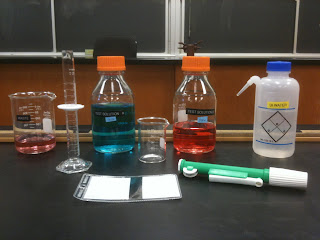This past week was the first week of actual labs, in which the students took scientific measurements using the international system of units. Measurements on mass, volume, length, and temperature were all included in the labs to give the students an understanding of proper measuring techniques and conversions.
My focus during the initial lecture of the labs was observing the teaching assistant in charge of the lab. He was mostly on the move around the room, explaining the metric system as well as asking questions to stimulate minds and helping students reach answers. His movement around the room also seemed to keep the lecture from getting dull, giving the students something to focus on as they listened.
After the lecture, the class headed outside to the small lake on campus where they took measurements. During this time the teaching assistant and I walked from group to group, assisting students and answering questions. When I was asked questions, I tried to do the same as the teaching assistant. When I could I attempted to help the student answer their own question by pointing out certain facts. It takes a little longer than giving a direct answer, but it provides more experience and critical thinking for the student.
We returned to the classroom once the groups finished. Inside, the students took more measurements using graduated pipets and electronic balances. Stations were set up around the room, one with the electronic balance to measure seed, and the other had filled graduated cylinders that were measured by their menisci. Once again, the teaching assistant and I walked around the room, answering questions in the same manner. Afterward, the students worked on problem solving questions based on measurements to finish the lab.
This week’s lab material was solid in both providing information and presentation, but I think an addition could be made. The introduction to the lab touches briefly on U.S. customary units and their relationship to the international system of units. While the primary objective of this lab is to teach the international system, it could do with having a small section on measuring in U.S. customary units and converting them to the international system. This section would help develop unit conversion and real world skills if they would ever need to convert between the two systems in the future.
These are the items students used to measure volume, including graduated pipet, graduated cylinder, beakers, solutions, a meniscus reader, and DI water.
Tape measures, rulers, measuring wheels, and thermometers were all used during the outdoor activity.
This is the electronic balance, weigh boat, and seeds students used to measure mass.
These two graduated cylinders were measured by their meniscus to determine their volume.




